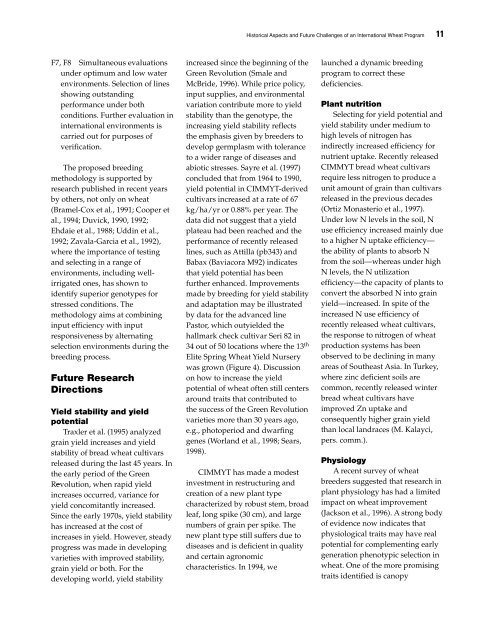Septoria and Stagonospora Diseases of Cereals - CIMMYT ...
Septoria and Stagonospora Diseases of Cereals - CIMMYT ...
Septoria and Stagonospora Diseases of Cereals - CIMMYT ...
Create successful ePaper yourself
Turn your PDF publications into a flip-book with our unique Google optimized e-Paper software.
F7, F8 Simultaneous evaluations<br />
under optimum <strong>and</strong> low water<br />
environments. Selection <strong>of</strong> lines<br />
showing outst<strong>and</strong>ing<br />
performance under both<br />
conditions. Further evaluation in<br />
international environments is<br />
carried out for purposes <strong>of</strong><br />
verification.<br />
The proposed breeding<br />
methodology is supported by<br />
research published in recent years<br />
by others, not only on wheat<br />
(Bramel-Cox et al., 1991; Cooper et<br />
al., 1994; Duvick, 1990, 1992;<br />
Ehdaie et al., 1988; Uddin et al.,<br />
1992; Zavala-Garcia et al., 1992),<br />
where the importance <strong>of</strong> testing<br />
<strong>and</strong> selecting in a range <strong>of</strong><br />
environments, including wellirrigated<br />
ones, has shown to<br />
identify superior genotypes for<br />
stressed conditions. The<br />
methodology aims at combining<br />
input efficiency with input<br />
responsiveness by alternating<br />
selection environments during the<br />
breeding process.<br />
Future Research<br />
Directions<br />
Yield stability <strong>and</strong> yield<br />
potential<br />
Traxler et al. (1995) analyzed<br />
grain yield increases <strong>and</strong> yield<br />
stability <strong>of</strong> bread wheat cultivars<br />
released during the last 45 years. In<br />
the early period <strong>of</strong> the Green<br />
Revolution, when rapid yield<br />
increases occurred, variance for<br />
yield concomitantly increased.<br />
Since the early 1970s, yield stability<br />
has increased at the cost <strong>of</strong><br />
increases in yield. However, steady<br />
progress was made in developing<br />
varieties with improved stability,<br />
grain yield or both. For the<br />
developing world, yield stability<br />
Historical Aspects <strong>and</strong> Future Challenges <strong>of</strong> an International Wheat Program 11<br />
increased since the beginning <strong>of</strong> the<br />
Green Revolution (Smale <strong>and</strong><br />
McBride, 1996). While price policy,<br />
input supplies, <strong>and</strong> environmental<br />
variation contribute more to yield<br />
stability than the genotype, the<br />
increasing yield stability reflects<br />
the emphasis given by breeders to<br />
develop germplasm with tolerance<br />
to a wider range <strong>of</strong> diseases <strong>and</strong><br />
abiotic stresses. Sayre et al. (1997)<br />
concluded that from 1964 to 1990,<br />
yield potential in <strong>CIMMYT</strong>-derived<br />
cultivars increased at a rate <strong>of</strong> 67<br />
kg/ha/yr or 0.88% per year. The<br />
data did not suggest that a yield<br />
plateau had been reached <strong>and</strong> the<br />
performance <strong>of</strong> recently released<br />
lines, such as Attilla (pb343) <strong>and</strong><br />
Babax (Baviacora M92) indicates<br />
that yield potential has been<br />
further enhanced. Improvements<br />
made by breeding for yield stability<br />
<strong>and</strong> adaptation may be illustrated<br />
by data for the advanced line<br />
Pastor, which outyielded the<br />
hallmark check cultivar Seri 82 in<br />
34 out <strong>of</strong> 50 locations where the 13 th<br />
Elite Spring Wheat Yield Nursery<br />
was grown (Figure 4). Discussion<br />
on how to increase the yield<br />
potential <strong>of</strong> wheat <strong>of</strong>ten still centers<br />
around traits that contributed to<br />
the success <strong>of</strong> the Green Revolution<br />
varieties more than 30 years ago,<br />
e.g., photoperiod <strong>and</strong> dwarfing<br />
genes (Worl<strong>and</strong> et al., 1998; Sears,<br />
1998).<br />
<strong>CIMMYT</strong> has made a modest<br />
investment in restructuring <strong>and</strong><br />
creation <strong>of</strong> a new plant type<br />
characterized by robust stem, broad<br />
leaf, long spike (30 cm), <strong>and</strong> large<br />
numbers <strong>of</strong> grain per spike. The<br />
new plant type still suffers due to<br />
diseases <strong>and</strong> is deficient in quality<br />
<strong>and</strong> certain agronomic<br />
characteristics. In 1994, we<br />
launched a dynamic breeding<br />
program to correct these<br />
deficiencies.<br />
Plant nutrition<br />
Selecting for yield potential <strong>and</strong><br />
yield stability under medium to<br />
high levels <strong>of</strong> nitrogen has<br />
indirectly increased efficiency for<br />
nutrient uptake. Recently released<br />
<strong>CIMMYT</strong> bread wheat cultivars<br />
require less nitrogen to produce a<br />
unit amount <strong>of</strong> grain than cultivars<br />
released in the previous decades<br />
(Ortiz Monasterio et al., 1997).<br />
Under low N levels in the soil, N<br />
use efficiency increased mainly due<br />
to a higher N uptake efficiency—<br />
the ability <strong>of</strong> plants to absorb N<br />
from the soil—whereas under high<br />
N levels, the N utilization<br />
efficiency—the capacity <strong>of</strong> plants to<br />
convert the absorbed N into grain<br />
yield—increased. In spite <strong>of</strong> the<br />
increased N use efficiency <strong>of</strong><br />
recently released wheat cultivars,<br />
the response to nitrogen <strong>of</strong> wheat<br />
production systems has been<br />
observed to be declining in many<br />
areas <strong>of</strong> Southeast Asia. In Turkey,<br />
where zinc deficient soils are<br />
common, recently released winter<br />
bread wheat cultivars have<br />
improved Zn uptake <strong>and</strong><br />
consequently higher grain yield<br />
than local l<strong>and</strong>races (M. Kalayci,<br />
pers. comm.).<br />
Physiology<br />
A recent survey <strong>of</strong> wheat<br />
breeders suggested that research in<br />
plant physiology has had a limited<br />
impact on wheat improvement<br />
(Jackson et al., 1996). A strong body<br />
<strong>of</strong> evidence now indicates that<br />
physiological traits may have real<br />
potential for complementing early<br />
generation phenotypic selection in<br />
wheat. One <strong>of</strong> the more promising<br />
traits identified is canopy









